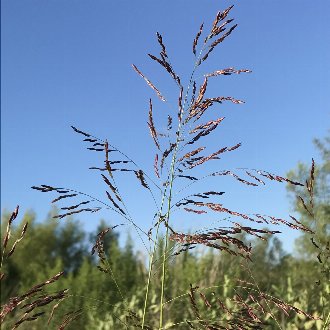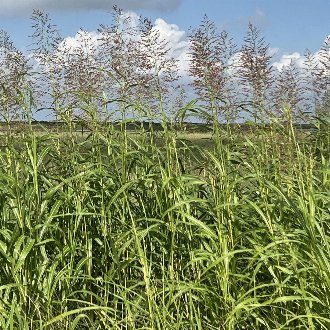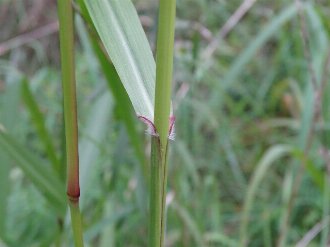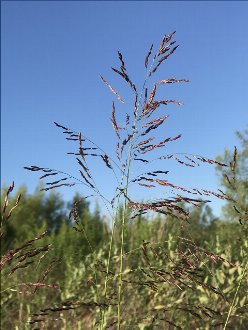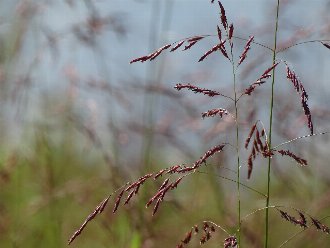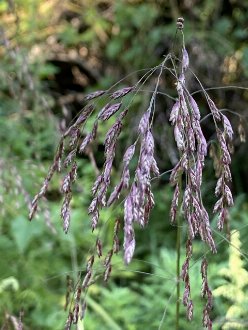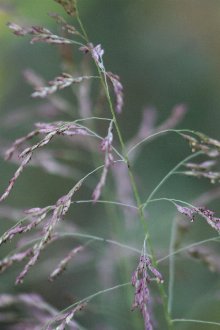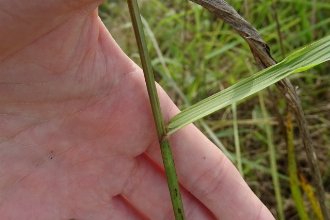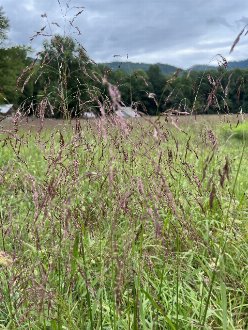Purpletop (Tridens flavus (L.) Hitchc.)
Also known as purpletop tridens.
↑Summary
A warm-season perennial grass native to the eastern US, found in sunny, disturbed habitats.
↑Range - Expand
| Legend | Color |
| Native or Not Present | |
| Native | |
| Expanded or Not Present | |
| Native or Expanded |
This tentative map is based on our own research. It may have limited data on Canada and/or Mexico, and there is some subjectivity in our assignment of plants as introduced vs. expanded. Read more in this blog post.
Although this plant occurs somewhere in each of these regions, it may only occur in a small part of some or all of them.
↑Similar Plants
↑Habitat
Purpletop is found in a variety of sunny, disturbed habitats in a wide range of conditions. It is limited to regions receiving more than 30 inches of rainfall annually, and in the north of its range it is also limited by cold. Natural habitats include woodland openings, limestone glades, and barrens. Often more common and widespread in anthropogenic habitats, including pastures and other agricultural land, roadsides, railroads, powerline clearances in wooded areas, and industrial waste ground.
Purpletop prefers soil with loam to clay-loam textures, but also tolerates other soil textures, including sands and thin soil over bedrock. Prefers soil of low fertility due to reduced competition from other plants, and persists longer on these sites, but it can be found temporarily on richer soils following disturbance. It tolerates some salt, helping it to grow along roadsides.
Regular mowing tends to benefit purpletop, especially if it is carried out in late spring, shortly before its emergence. Purpletop is often most abundant on sites that are mowed once a year, but it can be found temporarily on sites that are mowed less frequently or more. It cannot persist in a frequently-mowed lawn.
Prefers full sun but can tolerate some shade on the sides. However, it is intolerant of heavy competition from ground-level vegetation; it can be outcompeted by cool-season vegetation that retains its foliage into the warmer months, as well as by more robust warm-season grasses. It is usually absent from mature grasslands where it cannot compete long-term with other vegetation. It is more common on sites that would naturally be forested, but have been cleared or have experienced temporary disturbance.
↑Faunal Associations
Seeds are consumed by a variety of birds, including larger birds such as the northern bobwhite and wild turkey. It is also used as material for nests or dens of various animals.
↑Uses
Purpletop is often used as a forage for livestock; it is happily consumed by any type of grass-eating livestock. Livestock tends to prefer grazing it most early in the season, and then again after a frost. It is particularly suited for sites with shallow, drought-prone, or nutrient-poor soils that most other forage grasses struggle on. It can be planted either on its own or in a mix with other warm-season grasses. It sometimes fares poorly if mixed with cool-season grasses, especially on richer sites, but under some circumstances it can be mixed effectively with cool-season grasses and legumes to create more consistent forage throughout the seasons.
Purpletop can also be used as an ornamental grass, where it is used for the distinctive, attractive dark purple seedheads. It is generally easy to grow in landscaping and will tolerate a wide variety of different sites, but it tends to have thinner seedheads than most ornamental grasses. It is often most visible and distinctive when large amounts of it are viewed from a distance. If grown on richer sites, it will often be overtaken by other vegetation and create more of a need for weeding.
↑Related Plants
There are nine other Tridens species found in North America, all native; none are as common and widespread as T. flavus but all of them overlap somewhere, mostly in Texas.
↑Links & External Resources
• Tridens flavus (purpletop tridens) | USDA PLANTS Database (About This Site)
• Tridens flavus | Go Botany (About This Site)
• Purpletop Tridens | iNaturalist (About This Site)
• Tridens flavus | Biota of North America Project (BONAP) (About This Site)
• Purpletop (Tridens flavus cupreus) | Illinois Wildflowers (About This Site)
• Tridens flavus | NatureServe Explorer (About This Site)
• Tridens flavus | Flora of North America (About This Site)
• Purpletop Tridens | Maryland Biodiversity Project (About This Site)
• Tridens flavus (L.) A.S. Hitchc. (Purpletop, Tall Redtop) | Digital Atlas of the Virginia Flora (About This Site)



